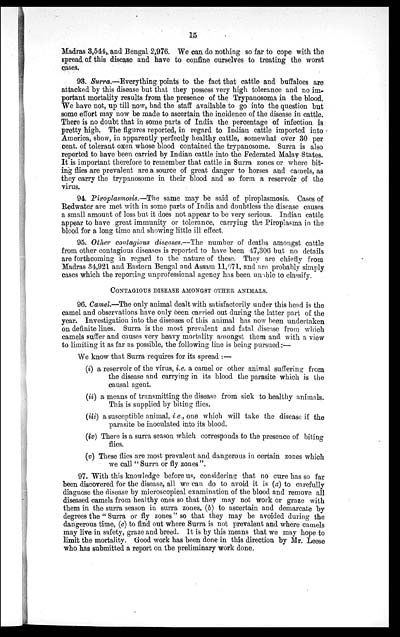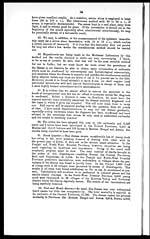Medicine - Veterinary > Civil Veterinary Departments > Annual administration report of the Civil Veterinary Department of India > 1907-1908 > Part A - Provincial administration
(26) Page 15
Download files
Individual page:
Thumbnail gallery: Grid view | List view

15
Madras 3,544, and Bengal 2,976. We can do nothing so far to cope with the
spread of this disease and have to confine ourselves to treating the worst
cases.
93. Surra.—Everything points to the fact that cattle and buffaloes are
attacked by this disease but that they possess very high tolerance and no im-
portant mortality results from the presence of the Trypanosoma in the blood.
We have not, up till now, had the staff available to go into the question but
some effort may now be made to ascertain the incidence of the disease in cattle.
There is no doubt that in some parts of India the percentage of infection is
pretty high. The figures reported, in regard to Indian cattle imported into
America, show, in apparently perfectly healthy cattle, somewhat over 30 per
cent. of tolerant oxen whose blood contained the trypanosome. Surra is also
reported to have been carried by Indian cattle into the Federated Malay States.
It is important therefore to remember that cattle in Surra zones or where bit-
ing flies are prevalent are a source of great danger to horses and camels, as
they carry the trypanosome in their blood and so form a reservoir of the
virus.
94. Piroplasmosis.—The same may be said of piroplasmosis. Cases of
Redwater are met with in some parts of India and doubtless the disease causes
a small amount of loss but it does not appear to be very serious. Indian cattle
appear to have great immunity or tolerance, carrying the Piroplasma in the
blood for a long time and showing little ill effect,
95. Other contagious diseases.—The number of deaths amongst cattle
from other contagious diseases is reported to have been 47,306 but no details
are forthcoming in regard to the nature of these. They are chiefly from
Madras 34,921 and Eastern Bengal and Assam 11,671, and are probably simply
cases which the reporting unprofessional agency has been unable to classify.
CONTAGIOUS DISEASE AMONGST OTHER ANIMALS.
96. Camel.—The only animal dealt with satisfactorily under this head is the
camel and observations have only been carried out during the latter part of the
year. Investigation into the diseases of this animal has now been undertaken
on definite lines. Surra is the most prevalent and fatal disease from which
camels suffer and causes very heavy mortality amongst them and with a view
to limiting it as far as possible, the following line is being pursued:—
We know that Surra requires for its spread:—
(i) a reservoir of the virus, i.e. a camel or other animal suffering from
the disease and carrying in its blood the parasite which is the
causal agent.
(ii) a means of transmitting the disease from sick to healthy animals.
This is supplied by biting flies.
(iii) a susceptible animal, i.e., one which will take the disease if the
parasite be inoculated into its blood.
(iv) There is a surra season which corresponds to the presence of biting
flies.
(v) These flies are most prevalent and dangerous in certain zones which
we call "Surra or fly zones".
97. With this knowledge before us, considering that no cure has so far
been discovered for the disease, all we can do to avoid it is (a) to carefully
diagnose the disease by microscopical examination of the blood and remove all
diseased camels from healthy ones so that they may not work or graze with
them in the surra season in surra zones, (b) to ascertain and demarcate by
degrees the "Surra or fly zones" so that they may be avoided during the
dangerous time, (c) to find out where Surra is not prevalent and where camels
may live in safety, graze and breed. It is by this means that we may hope to
limit the mortality. Good work has been done in this direction by Mr. Leese
who has submitted a report on the preliminary work done.
Set display mode to: Large image | Zoom image | Transcription
Images and transcriptions on this page, including medium image downloads, may be used under the Creative Commons Attribution 4.0 International Licence unless otherwise stated. ![]()
| Permanent URL | https://digital.nls.uk/75509504 |
|---|




